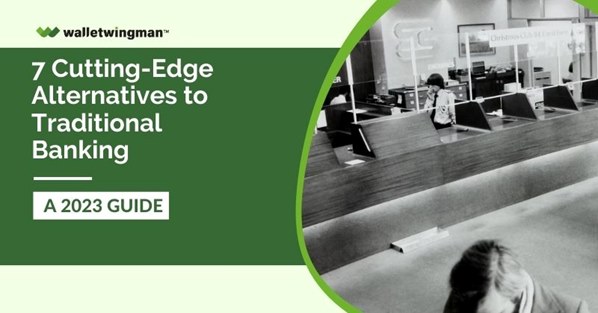For generations, traditional banking has served as the foundation of financial institutions, offering vital services, including savings accounts, loans, and payment processing.
However, cutting-edge alternatives to traditional banking have become possible due to technological advancements and shifting consumer tastes.
These cutting-edge technologies provide a number of advantages, including improved security, lower prices, and greater accessibility. We will look at seven of these options that are changing the financial landscape in this post.
These choices, which range from blockchain-based currencies and peer-to-peer lending platforms to digital banks and decentralized finance, are changing how we save, borrow from, and conduct financial transactions.
We will go into each option and analyze its special traits, benefits, and potential drawbacks to shed light on the banking industry’s future in the quickly developing digital era.
The Necessity for a Non-traditional Banking
The necessity of traditional banking alternatives stems from various factors that highlight the limitations and shortcomings of the traditional banking system. Here are five reasons why these alternatives are necessary:
1. Accessibility
Traditional banking services may have geographical restrictions because physical branches are only present in certain places.
This may provide hurdles for people who struggle to access essential banking services in distant or underdeveloped areas. Providing simple and accessible banking services to a larger population, alternative solutions like digital banks and mobile payment apps offer a solution.
2. Expense-Effectiveness
Maintaining physical branches and a sizable workforce is a significant overhead expense for traditional banks.
Customers frequently pay fees and levies to cover these expenditures. Contrarily, several alternatives to conventional banking have efficient technology operations that enable them to provide services at reduced costs or even for free. They appeal to anyone looking for cost-effective financial solutions because of their cost-effectiveness.
3. Innovation and Convenience

Traditional banks may struggle to keep up with changing consumer demands and technological improvements since outdated systems and bureaucratic procedures hamper them.
Peer-to-peer lending platforms, robo-advisors, and decentralized finance are alternatives to banks that use cutting-edge technology to provide creative and practical financial services. They provide simplified methods, user-friendly user interfaces, and advanced technologies that improve the banking experience.
4. Financial Inclusion
A sizeable section of the world’s population still lacks access to formal financial services and is either underbanked or unbanked. These people may be unable to access traditional banking services due to stringent documentation requirements, credit history checks, and minimum deposit requirements.
Alternative solutions, such as online banks and mobile payment apps, can have lower entry hurdles, making them more accessible and enabling financial inclusion for hitherto underserved groups.
5. Security and Transparency
Data breaches and identity theft show that traditional banks are not immune to fraud and security lapses. Alternative banking options provide increased security and transparency, particularly those that use blockchain technology.
Blockchain’s decentralized structure guarantees data integrity, while cryptography secures transactions. Users’ trust is improved as a result of the increased security and transparency, which also helps to reduce the dangers related to traditional banking.

1. Digital Banks
Neobanks, often digital banks, are online-only financial institutions without physical locations. Through the use of technology, these institutions provide a smooth and user-friendly banking experience. Digital banks offer various services, including checking and savings accounts, payment processing, and budgeting tools.
They are well known for their convenience, with 24/7 access to banking services through mobile apps and websites. Additionally, digital banks usually have lower fees than traditional ones, making them a good option for people on a budget.
Due to some people’s reluctance to trust a bank that doesn’t have a physical location with their money, digital banks continue to struggle with consumer trust issues. The two biggest problems are still security and regulatory compliance.
But as Internet banking gains popularity, we can expect further innovations and advancements in this area.

2. Peer-to-Peer Lending Platforms
Peer-to-peer (P2P) lending systems link borrowers and lenders directly and have become a viable alternative to savings accounts.
These platforms do away with the usual lending intermediaries, allowing for affordable access to credit for both people and small businesses. P2P lending systems use technology to match lenders and borrowers according to their creditworthiness and requirements.
Due to the absence of drawn-out approval procedures connected to banks, the process is frequently quicker and more streamlined than traditional banking. Compared to conventional savings accounts or investments, P2P lending presents a chance for investors to generate higher returns.
P2P financing does not, however, come without dangers. Default rates and loan delinquencies may impact the profits for lenders, and regulatory frameworks for P2P lending are still developing in many jurisdictions.
Despite the difficulties, P2P lending is becoming increasingly popular, offering both individuals and businesses an alternate funding source.
3. Cryptocurrencies and Blockchain Technology
Compared to traditional banking, cryptocurrencies provide many benefits, such as quicker international transactions, fewer fees, and greater anonymity.
Beyond mere currencies, the underlying technology behind cryptocurrencies, known as the blockchain, has the power to transform the banking industry completely.
Compared to traditional banking, cryptocurrencies provide many benefits, such as quicker international transactions, fewer fees, and greater anonymity.
Beyond mere currencies, the underlying technology behind cryptocurrencies, known as the blockchain, has the power to transform the banking industry completely.
It can be applied to smart contracts, identity verification, etc. But there are also problems with cryptocurrency and blockchain technology.
Concerns like price volatility, regulatory uncertainty, and scalability limitations must be resolved for widespread adoption. Despite these obstacles, cryptocurrencies and blockchain technology continue revolutionizing the banking sector and present intriguing opportunities.
4. Mobile Payment Apps
The way we make payments and manage our finances has changed due to mobile payment apps.
Users can link their bank accounts or credit cards to their cell phones using these apps like Apple Pay, Google Pay, and Venmo to enable rapid and safe transactions. Mobile payment apps are convenient because they eliminate the need to carry actual wallets or credit cards.
They offer extra services like bill splitting, peer-to-peer payments, and budgeting tools. However, the requirement for widespread merchant adoption is one of the difficulties that mobile payment apps confront.
Although these apps are becoming increasingly popular, not all retailers accept mobile payments, which limits their applicability in some circumstances.
Security issues, including the possibility of data breaches or unauthorized access, must also be addressed to keep users’ trust.
Despite the difficulties, mobile payment apps are becoming increasingly a part of our daily lives and are anticipated to have a significant impact on banking in the future.
5. Robo-Advisors
Robo-advisors are automated investment systems that offer specialized money management and financial guidance.
These platforms analyze a user’s financial objectives, risk tolerance, and investment preferences using algorithms and artificial intelligence, designing and managing an investment portfolio in accordance.
Compared to traditional financial advisors, robo-advisors have several benefits, including lower fees, greater accessibility, and transparency.

They offer a variety of investment opportunities to a broad range of investors, from novices to seasoned investors. However, building and sustaining customer trust is one of the difficulties robo-advisors face.
Some people like the personalized service and knowledge provided by traditional financial consultants.
Additionally, because their algorithms might not be able to consider all external circumstances, robo-advisors may have difficulties during market downturns or uncertain economic conditions.
Despite these difficulties, robo-advisors are becoming increasingly well-liked as a viable alternative to traditional banks for investment services.
6. Crowdfunding Platforms
Platforms for crowdfunding have completely changed how businesses, artists, and non-profit organizations raise money. These platforms allow people or organizations to showcase their ideas or projects to a big audience and ask for financial support.
Crowdfunding can take many forms, including equity-based crowdfunding, crowdfunding based on rewards, and crowdfunding based on donations. Bypassing conventional banking channels, it offers a different source of finance.
Platforms for crowdfunding provide advantages such as improved access to cash, market validation, and community involvement. Crowdfunding has its difficulties, though. Not all projects successfully raise the necessary funds due to the intense competition for money and attention.
For both project developers and contributors, there are regulatory considerations and potential hazards. Despite the difficulties, crowdfunding sites continue to give people power and democratize the funding process, providing a different way to raise money.
7. Decentralized Finance (DeFi)
Decentralized finance, also known as DeFi, uses blockchain technology to replicate established financial systems in a permissionless and decentralized fashion. Without intermediaries, DeFi applications seek to deliver financial services like lending, borrowing, trading, and earning interest.
Smart contracts, which are self-executing contracts with the terms of the agreement put straight into code, are the foundation of these applications.
DeFi has several benefits, including improved accessibility, global reach, and transparency.
It allows people to manage their money entirely and engage in financial operations without authorization from centralized entities.
DeFi faces scalability problems, regulatory compliance, and smart contract vulnerabilities. We may anticipate seeing more cutting-edge applications and solutions tackling these problems as the DeFi ecosystem develops, potentially altering the direction of banking and finance.
Conclusion
Modern alternatives to traditional banking are developing, drastically changing the financial industry.
The economic environment is changing due to digital banks, peer-to-peer lending platforms, cryptocurrencies and blockchain technology, mobile payment apps, robo-advisors, crowdfunding media, and decentralized finance.
Compared to traditional banking, these alternatives provide more accessibility, convenience, cost savings, and improved security.
However, companies also struggle with scalability, cybersecurity, law, and trust. As technology advances and consumer preferences shift, these alternatives must address these concerns and provide robust systems that encourage confidence and trust.
The integration of technology and financial services will impact how we manage our money and engage with the financial ecosystem, and this is where the future of banking rests.



